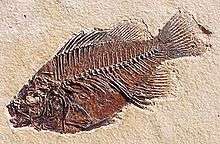Priscacara
| Priscacara Temporal range: Eocene | |
|---|---|
 | |
| Priscacara liops | |
| Scientific classification | |
| Kingdom: | Animalia |
| Phylum: | Chordata |
| Class: | Actinopterygii |
| Order: | Perciformes |
| Family: | Percidae |
| Genus: | Priscacara Cope 1877 |
| Species | |
| |
Priscacara is an extinct genus of perch from the middle Eocene. It is characterized by a sunfish-like body and its stout dorsal and anal spines.[1] The fish is best known from the Green River Shales of Wyoming, Utah and Colorado. Mass deaths of Priscacara suggest it formed schools[1].
Two species are recognized,[2] of which the smaller species, P. liops is the most common. Priscacara fossils are common in the Fossil Lake deposits of western-most Wyoming and is rare in the Lake Gossiute deposits of Wyoming and the Lake Uinta deposits of Utah and Colorado[1]. It also occurs in the middle Eocene lake deposits of Washington and British Columbia[1].
A phylogenetic review of Priscacara by Whitock[2], found only two species, P. serrata and P. liops. The two species differ in the number of dorsal and anal fin rays, as well as possibly a coarser serrated rear edge of the preopercle in P. serrata[2],. P. liops also has small conical teeth on the pharyngeal jaw, whereas P. serrata has large grinding toothplates[2], suggesting a diet of snails and crustaceans[1].

References
- ↑ Grande, L. (1984). Paleontology of the Green River Formation, with a review of the fish fauna. Geological Survey of Wyoming Bulletin 63: 1-333
- ↑ Whitlock, J. A. (2010). Phylogenetic relationships of the Eocene percomorph fishes Priscacara and Mioplosus. Journal of Vertebrate Paleontology, 30(4), 1037-1048.
Sources
- Fossils (Smithsonian Handbooks) by David Ward (Page 220)